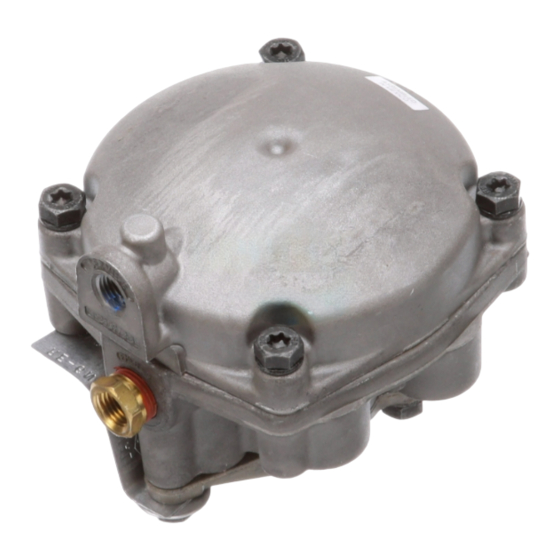BENDIX RE-6NC Manual - Page 7
Browse online or download pdf Manual for Control Unit BENDIX RE-6NC. BENDIX RE-6NC 13 pages. Relay valves

8. Use only genuine Bendix
components and kits. Replacement hardware,
tubing, hose, fi ttings, etc. must be of equivalent
size, type and strength as original equipment and
be designed specifi cally for such applications and
systems.
9. Components with stripped threads or damaged
parts should be replaced rather than repaired. Do
not attempt repairs requiring machining or welding
unless specifi cally stated and approved by the
vehicle and component manufacturer.
10. Prior to returning the vehicle to service, make
certain all components and systems are restored
to their proper operating condition.
11. For vehicles with Antilock Traction Control (ATC),
the ATC function must be disabled (ATC indicator
lamp should be ON) prior to performing any vehicle
maintenance where one or more wheels on a drive
axle are lifted off the ground and moving.
PREVENTIVE MAINTENANCE
Important: Review the Bendix Warranty Policy before
performing any intrusive maintenance procedures. A
warranty may be voided if intrusive maintenance is
performed during the warranty period.
No two vehicles operate under identical conditions, as a
result, maintenance intervals may vary. Experience is a
valuable guide in determining the best maintenance interval
for air brake system components. At a minimum, the valve
should be inspected every 6 months or 1500 operating
hours, whichever comes fi rst, for proper operation. Should
the valve not meet the elements of the operational tests
noted in this document, further investigation and service
of the valve may be required.
SERVICE CHECKS
1. Remove any accumulated contaminants. Visually
inspect the valve's exterior for excessive corrosion
or physical damage. Repair/replace the valve as
necessary.
2. Inspect all air lines connected to the valve for signs
of wear or physical damage. Repair/replace as
necessary.
3. Test air line fi ttings for excessive leakage and tighten
or replace as necessary.
OPERATIONAL AND LEAKAGE TESTS
1. Block the vehicle's wheels and fully charge the air
system.
2. Apply and release the service brakes several times
and check for prompt response of the brakes at all
appropriate wheels.
3. With the air system fully charged, apply a soap solution
™
to the RE-6
or RE-6NC
Leakage of a 1" bubble in 5 seconds is permissible.
®
replacement parts,
™
valve's exhaust port.
4. Make and hold a full brake application and again
apply a leak check solution to the RE-6
valve's exhaust. Leakage of a 1" bubble in 3 seconds
is permissible.
5. With the brakes still applied, apply a leak check solution
around the valve where the cover meets the body. No
leakage at this point is permitted.
If the valve does not function as described; or if leakage is
excessive, repair the valve or replace it at any authorized
parts outlet.
REMOVAL
1. Identify, mark or label all air lines and their connections
to the RE-6
™
or RE-6NC
the body of the valve, including the valve cover.
When the assembly process is reached, the line will
serve as a reference to the position of the valve cover
on the valve body. Disconnect the air lines.
2. Remove the RE-6
vehicle.
INSTALLATION
1. Use the mounting bracket provided with the valve, or,
if securing the valve to a reservoir, use a Schedule 80
(heavy wall) short couple, pipe nipple.
2. Reconnect all air lines to the valve using the identifi cation
made during removal.
3. Test all air fi ttings for excessive leakage and tighten
as needed. Also, perform OPERATIONAL AND
LEAKAGE TESTS before placing the vehicle back into
service.
DISASSEMBLY
The following procedure is for reference only. Always
have the appropriate maintenance kit on hand, and use its
instructions in lieu of those presented here. Refer to Figure
12 throughout. CAUTION: The RE-6
may be lightly clamped in a bench vise during disassembly.
However, over-clamping will cause damage to the valve
and result in leakage and/or malfunction. If a vise is used,
position the valve so the jaws bear on the supply ports on
opposing sides of the valve's body.
1. Remove the four screws that secure the cover to the
body, set aside, and then slowly remove the cover.
2. Remove and discard the sealing ring(6) from sealing
ring grove located at the top of the valve body.
3. If a spring(5) is present (positioned between the bottom
side of the relay piston and the upper portion of the
valve body) set aside for the assembly process.
4. Remove the relay piston(3) from the valve body. It may
be necessary to tap the valve body lightly in order to
dislodge the relay piston from the valve cover.
5. Remove and discard the large o-ring(2) on the relay
piston.
6. Remove and discard the exhaust valve seat(4) from
the relay piston.
™
or RE-6NC
™
valve. Scribe a line across
™
or RE-6NC
™
valve from the
™
& RE-6NC
™
™
valve
7
